Camellia Care
Where Will They Grow?
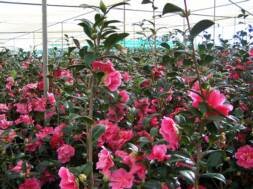
Camellias are a tough and hardy breed of plants.
Camellia sasanqua, whilst not as well known as their japonica cousins, are gaining popularity worldwide for their vigor versatility and ease of growth.
Australia is a world leader in the breeding and development of Camellias sasanqua and plants are being successfully grown throughout Australia from the south east Queensland all along the east coast through to Melbourne, Tasmania in the south and in Adelaide and Perth further west.
Sasanquas have also been tried and tested in Canberra, the Southern Highlands of NSW and in the populated regions west of the Great Dividing Range.
Planting Out & Soil
If the soil is friable and well prepared planting should not be a problem. When removing plants from pots, take care not to pull the plant out by the stem as this can damage the root system. Tap the top lip of the pot in a downward direction and the pot should fall away easily.
Once free of the pot, the root ball can be teased out a little. This frees up some of the roots and encourages them to move out into the new soil. As a rule of thumb, make the planting hole twice the size of the root ball. Use good quality potting mix or rich, friable soil to back-fill around the plant. Firm the plant in by gently pressing the soil down around the root ball. Ensure that the top of the soil level in the pot is level with the top of the soil in the ground. Planting too deep is often fatal.
Water in your new planting immediately. A deep thorough watering is required initially, even if the soil is already moist. This helps to 'seat' the plant in.
Do not dig a hole in clay soil to plant your camellias. Clay soils need to be conditioned with the addition of organic matter, such as well composed manures or composted garden waste. Make sure the location is free draining and if possible the construction of a raised garden bed is ideal. If the position is water logged your plant will die.
Staking & Espalier
Staking
It is advisable to stake your camellia when you plant. As your sasanqua grows the new growth often bends over until the wood hardens. By staking you will produce a larger plant more quickly. Drive the stake in 3-5cm from the trunk and loosely tie the plant to the stake with soft twine, velcro strips or linen, etc. Use a stake taller than the plant so that as the plant grows you can continue to stake it.
Espalier
Camellia sasanquas are ideal for espalier. Their glossy foliage and prolific flowering habit are perfect for training fan-like against a wall, fence or lattice work. In addition, tolerance to most garden soils and aspects makes the Camellia sasanqua one of the best plants to espalier. Some varieties are better than others; those with arching branches are the most desirable.
Pruning & Bonsai
Pruning
Where there is vigorous young growth Camellia sasanquas often look 'leggy'. We do not advise heavy pruning of this growth as the next growth flush fills out the plants. Prune at any time of the year but remember your flowers form on the growth made in spring. Prune off this spring growth and you will also be pruning off your flowers. The best time to prune is when flowering has finished, in early to mid-winter.
Bonsai
Camellia sasanquas are often used as bonsai specimens. Our Paradise dwarf growing varieties can, with patience, grow into delightful plants. Varieties we recommend are: Paradise Baby Jane, Paradise Petite, Paradise Little Liane, Paradise Sylvia.
Pots & Tubs
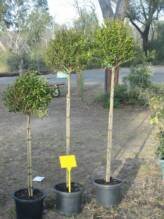
Camellia sasanquas make lovely container plants which can be kept in pots on your verandah or balcony for many years. Potted plants are best pruned annually after flowering to maintain their desired size. Every three years the plant should be removed from its pot and the outer 5cm or so of soil and roots removed. Re-pot with new potting mix preferably in late winter and your plant will happily grow in the same container indefinitely. Feed regularly in late spring and summer but never in autumn or winter. Winter feeding can result in leaves dropping and you could lose the entire plant.
Sun & Shade
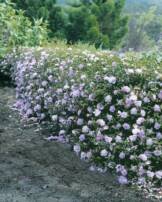
Camellia sasanqua grow equally well in sun or in shade. In full sun they benefit from thick mulch applied around the plant to keep the roots cool in summer. Where conditions are very hot or windy, a screen of shade cloth or sacking for the first year can protect young plants.
We are often asked if Camellia sasanqua grow in full shade. Yes they do. They love shade. In very shady place their growth habit may be more open but otherwise they grow and flower well in these conditions.
Pests & Diseases
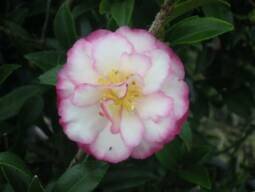
Camellias which are planted in well-drained soil, and fed regularly, are rarely affected by pests and diseases. They are one of the easiest plants to grow and will reward you by flowering from late summer through to early winter. For identification of specific problems, take a sample in to your local garden center and ask for advice.
Mulch & Frosts
Mulch
A mulch on the top of the soil around your plant reduces moisture loss, keeps conditions cool and damp, provides long term nutrition for your plants and reduces weed growth. This is very beneficial to the health of the plant. Materials such as pine bark, wood chips, compost, fallen leaves, sugar cane mulch etc. are suitable for mulching. For most camellia plants a mulch depth of 2.5-5.0cm is sufficient.
Frosts
Being autumn flowering, Camellia sasanquas usually flower before frost can damage the blooms. Early frost can, however, damage the flowers in the colder areas. In cold, frosty, open areas the foliage discolours and looks quite ill. But with the return of warm weather the plants happily grow on again.
Watering & Feeding
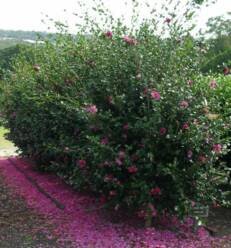
Watering
After planting you must water around the base of each camellia regularly for several weeks. This is most important. Sometimes the original root ball (which used to be in the pot) can dry out even though the new surrounding soil is damp (especially on hot, dry or windy days). Leaf drop may result, so remember to water each plant individually. If the soil is well drained it is difficult to over water. Waterlogging can produce the same results as drying out.
Feeding
The most frequent reason camellias die is because they are overfed or fed at the wrong time. Feed your camellias only in spring or summer. You normally buy camellias in autumn or winter BUT IF YOU BUY AND APPLY YOUR FERTILIZER AT THE SAME TIME YOU WILL PROBABLY KILL THEM! So be patient and wait until spring TO FEED.
How much food depends on the type of fertiliser you use. For young & containerised plants, slow release fertilisers (such as Osmocote or Nutricote) are recommended. An application once in spring is recommended. Large, established plants are best fed with Camellia and Azalea food once in spring and again in mid-summer. Use one handful per square meter of surface area, but no more. Manures are good to use but take care not to use to much at once especially with poultry manure - a little used often is best.
Over feeding results in very lush new growth, followed by massive leaf drop. This is most often occurs when plants are fed with fast releasing fertilisers (liquid feed or manures) in the cooler months, but can happen at any time. Often, over-caring gardeners will give their plants an extra dose with liquid fertiliser once they see leaf-drop, and this is usually the final nail in the camellia coffin. Never fertilise a plant that appears to be ailing. Remember, it takes ages for a camellia to die from starvation, but only days for it to die from over-feeding.